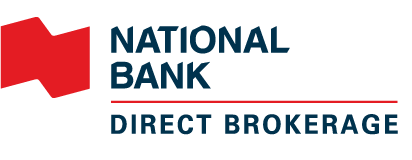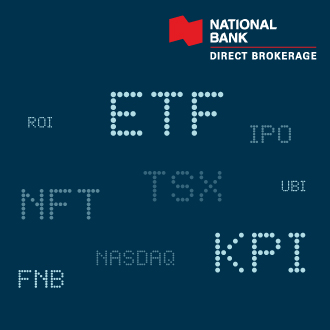Learn about dividend investing and how dividend paying securities can be used to create a diversified portfolio with a regular stream of income.

Investors can save their dividends, invest them or, depending on the type of account held in, they can cash them into their bank account. Want to learn more about dividends?
Learn how a dividend reinvestment plan works, the different types available to self-directed investors, the advantages & disadvantages and how to set up a DRIP with National Bank Direct Brokerage.
What is Dividend Reinvestment?
When a security declares cash dividends, the registered shareholder can take the cash payment. It can be paid into the investor’s brokerage account or, when available, elect to have those dividends reinvested into the same security by having additional shares purchased.
What is a Dividend Reinvestment Plan (DRIP)?
A DRIP is a program that allows investors to automatically reinvest their cash dividends or distributions earned on their stocks or ETFs into additional shares or units. Only full shares can be purchased, the remaining amount is paid in cash into the investor’s brokerage account.
How does a dividend reinvestment plan work?
Let’s say an investor owns 200 shares of XYZ company’s stock and has elected to be part of the DRIP. XYZ declares a quarterly dividend of $0.40 per share and the share price on the payment date of the dividend is $38.00. The dividend received of $80.00 allows the registered shareholder to buy at zero brokerage commission 2 shares of XYZ company and the remaining amount would be paid into their brokerage account.
Types of DRIPs for self-directed investors?
● Treasury DRIPs refers to a dividend reinvestment program that is automated and managed directly by the company or by a third party such as a transfer agent.
● Synthetic DRIPS or Brokerage managed DRIPs are for companies that don’t offer a reinvestment program. Most direct brokerage firms have created their own program and purchase additional full shares automatically at zero brokerage commission to the investor.
● Self-directed DRIPs are a manual purchase made by the investor using the dividend payment and/or liquidity in the brokerage account. With zero commissions to buy or sell common shares and ETFs with NBDB, clients can take advantage of this possibility.
Treasury and Synthetic DRIPS are fully automated once the investor
has requested them. Self-directed DRIPS, on the other hand, require
the investor to place the transactions themselves.
Find dividend paying securities with Strategy builder
Pros & Cons of DRIPs
When deciding if DRIP investing is the right option for you, there are several advantages and disadvantages to take into consideration.
| Pros | Cons |
|---|---|
| Dollar-cost-averaging let's you buy shares at regular intervals | Concentration risk: over time, DRIPs on the same security can cause your portfolio to deviate.. You could eventually have a higher exposure to this one security or market sector. |
| Automatic investing: once the DRIP is set the rest takes care of itself | Income taxes: Even though dividends are favorably taxed in Canada, unless the DRIP is set up in a registered account taxes could be owing. |
| Encourages long term thinking: you might be less likely to panic and sell securities because of the DRIP. You can buy additional shares when the price decreases. | Cash amount: If the cash dividend isn’t enough to purchase an additional share the DRIP will not occur. For investors with smaller portfolios or securities with high share prices this can be an issue. |
Do you pay taxes on DRIP dividends?
The Canada Revenue Agency CRA considers dividend payments as an income source, whether the dividend is taken in cash or in a DRIP. When DRIPs are requested within a tax-sheltered account, such as a RRSP or TFSA there is no tax impact for the investor. If set up in a non-registered account, like a cash or margin account, the investor will have to declare this income when filing their taxes.
For certain types of securities such as Exchange Traded Funds (ETFs) and Real Estate Investment Trusts (REITs), the distribution received can be composed of capital gains, return of capital and other types of income.
In the case of a DRIP, the investor would need to request adjustments to the book value or average cost to reflect this. Many investors choose to forgo DRIPs for those types of securities or will hold them in tax-sheltered accounts.
How to reinvest dividends?
With just a few easy steps, clients of National Bank Direct Brokerage can request an automatic dividend reinvestment on over 2000 eligible securities.
- Buy a dividend paying security or select one already held in your brokerage account.
- Make sure the dividend payment (monthly or quarterly) is sufficient to purchase at least one additional share.
- Contact us via the secure messaging center and provide instructions on which stocks and ETFs to sign up for DRIPS.
- If available, the investor will be registered for the Treasury or Synthetic DRIP and will receive confirmation via the secure messaging center.
So many options to choose from
Many companies return profits to their registered shareholders in the form of dividends. In fact, investors have access to thousands of dividend paying securities listed in the Canadian and U.S. markets to choose from. Depending on your objectives a dividend reinvestment plan can be an easy solution to implement into your portfolio.
With zero commissions to buy or sell stocks and ETFs, take advantage of self-directed DRIPs.
Key takeaways
- A DRIP is a program that allows investors to automatically reinvest their cash dividends or distributions earned on their stocks or ETFs into additional shares or units.
- A great option for investors looking to reinvest their dividends into additional shares of the security.
- Easily set up a DRIP using our secure messaging center.





